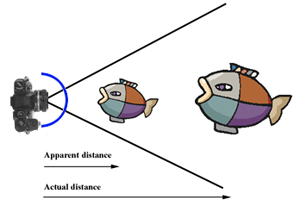Underwater camera housings may have flat or domed ports. A flat or plane port does nothing to correct for the different refractive indices of air and water, but may be more appropriate if some shots are to be taken above water. It may also be the best choice for use in close-up work where a relatively long focal-length lens is employed.
Flat ports cause a number of problems, one of the more apparent being that produced by refraction. Light is refracted as it passes through the water-to-air interface and objects appear about 25% closer and about 33% larger than they actually are. This is the same degree of magnification experienced by a diver looking through a flat face-mask. Flat ports also introduce significant radial distortion. Light entering the centre of the port is unaffected because there is no refraction, but rays entering further from the centre are increasingly refracted. The result is progressively worsening blur that is most apparent when using wide-angle lenses at large apertures. Chromatic aberration occurs when white light is refracted, in this case as it passes through the glass port from water to air, and is separated into the component colours of the visible spectrum. White light is a mixture of many different wavelengths and each wavelength is refracted to a slightly different extent. This results in a small degree of blurring in images. The effect is most noticeable when using wide-angle lenses.
 Domed ports are basically hemispherical and act as concentric optical lenses. They have the potential to eliminate or reduce the problems of refraction, chromatic and axial aberrations, and radial distortion. However, to achieve this the camera lens must be correctly positioned within the port. The nodal point of the lens, in general the location of the iris, should be located as precisely as possible at the centre of the sphere which defines the inner surface of the hemispherical port. Incoming light then passes through the port at right-angles to its surface and is consequently unaffected by refraction. The effective focal length and angle of view of the camera lens then remain unchanged. Domed ports can be used above water without any significant effect upon the image.
Domed ports are basically hemispherical and act as concentric optical lenses. They have the potential to eliminate or reduce the problems of refraction, chromatic and axial aberrations, and radial distortion. However, to achieve this the camera lens must be correctly positioned within the port. The nodal point of the lens, in general the location of the iris, should be located as precisely as possible at the centre of the sphere which defines the inner surface of the hemispherical port. Incoming light then passes through the port at right-angles to its surface and is consequently unaffected by refraction. The effective focal length and angle of view of the camera lens then remain unchanged. Domed ports can be used above water without any significant effect upon the image.
It is important to understand that a domed port acts as a lens and brings about significant optical change. It creates what is sometimes known as a virtual image a short distance in front of the camera lens, and the focusing scale on the camera lens is rendered unusable as the marked distances are no longer appropriate. Lenses must consequently be calibrated underwater. It also acts as a negative magnifier - that is, it makes objects appear smaller and closer than they actually are. This is not normally a problem with true wide-angle lenses because they generally have very short minimum focus distances. Lenses with focal lengths of 24mmor 35mm may have to be fitted with supplementary close-up lenses to achieve the necessary short focus distance.






